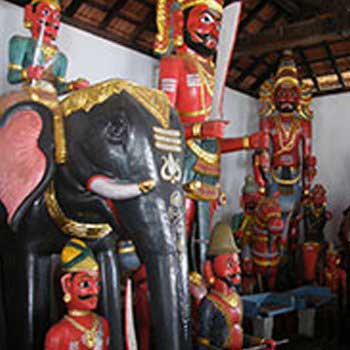Explore Mekekattu Nandikeshwara Temple: Ancient Legends and Cultural Riches

Mekekattu Nandikeshwara Temple is a historic site located about 20 kilometers from Kundapura, nestled within Udupi taluk's boundaries in a secluded area near Saibra Katte. Not far from Barkur in Shirya village, this site is steeped in legend. Allegedly constructed by Parshurama, it shares architectural similarities with other major temples along the coastal region of Karnataka. Believed to be over 1000 years old, the temple draws significant crowds during the Sankranti festival, particularly for its annual events, Hasara and Sedi.
Temple Facts:
A remarkable aspect of the Mekekattu Nandikeshwara Temple is its extensive collection of colorful wooden idols, many standing up to 10 feet tall. These idols are crafted from Halsa Mara (Jackfruit tree wood), abundant in nearby forests. Primarily depicted in warrior attire, these statues seem to commemorate a historical battle, speculated to have occurred between 1600-1700 A.D. during either the Mogul or Bahamani invasions, although no concrete evidence supports this theory. The idols, vibrant and towering, are periodically restored; the last restoration occurred in 1970, followed by a repaint in 2007. Of the 365 temples originally surrounding Barkur, only five remain active, with the rest having succumbed to ruin. Some statues even replicate ancient weaponry, poised as if ready for combat, and each bears a local legendary name.
Mythology & Folklore:
The temple is associated with two main legends. The first involves sage Parshurama, who summoned rain through a Yajna conducted by sage Agastiya during a severe drought. During this ritual, a demon named Asurakumbha disrupted the proceedings, until Bheema intervened and eliminated the threat with a sword bestowed by Lord Ganesha.
The second legend revolves around the Allupas Dynasty, which ruled portions of coastal Karnataka from 450-1400 C.E. Initially sovereign, they later became vassals to several dominant dynasties, including the Kadambas and the Vijaynagara Rayas. According to local lore, a king from this dynasty, seeking to fend off an attack, enlisted the aid of a sage from Jambur. In response, Lord Shiva dispatched his forces, led by Nandi, to vanquish the invaders, after which the grateful king erected the temple to honor Shiva’s army.
Accessibility:
Nearest railway stations to Mekekattu Nandikeshwara Temple:
Kundapura: 8 km
Saibrakatte: 2 km
Udupi: 26 km
FAQs about Mekekattu Nandikeshwara Temple:
What is the history behind Mekekattu Nandikeshwara Temple?
Mekekattu Nandikeshwara Temple, located near Saibra Katte in Udupi taluk, Karnataka, is believed to have been constructed over 1000 years ago by Parshurama. It stands out for its historical significance and architectural resemblance to other coastal Karnataka temples.
What are the unique features of Mekekattu Nandikeshwara Temple?
The temple is renowned for its collection of colorful, 10-feet-tall wooden idols crafted from Halsa Mara (Jackfruit tree wood). These statues, depicting warriors and ancient weaponry, commemorate a speculated historical battle and undergo periodic restoration to maintain their vibrancy.
What are the main festivals celebrated at Mekekattu Nandikeshwara Temple?
The temple hosts significant annual events, including Hasara and Sedi festivals, which draw large crowds, especially during Sankranti. These festivals are integral to local cultural celebrations and religious practices.
What mythology and folklore are associated with Mekekattu Nandikeshwara Temple?
The temple is steeped in two main legends: one involving sage Parshurama and a demon named Asurakumbha, and another linking it to the Allupas Dynasty's defense against invaders, aided by Lord Shiva's forces led by Nandi. These stories add to the temple's cultural and historical importance.
How can visitors access Mekekattu Nandikeshwara Temple?
The temple is conveniently accessible from:
Kundapura (8 km away)
Saibrakatte (2 km away)
Udupi (26 km away)
These locations provide railway connections, ensuring ease of travel for pilgrims and tourists alike.